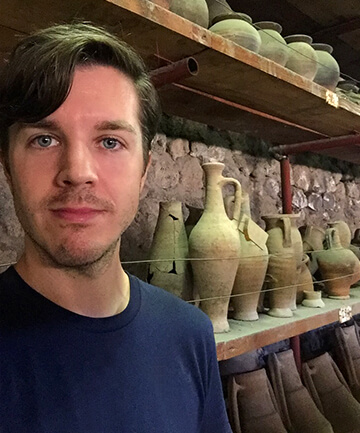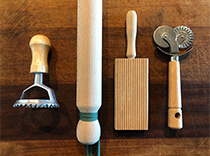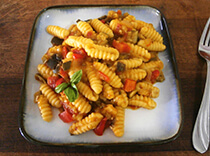Pasta Passion Captivates Food Historian
 Kitchen gadgets ancient and modern are household gods to food historian Aaron Brown (Classics, Humanities). When he’s not contemplating the culinary ways of Ancient Rome, the visiting assistant professor captures the aromatic essence of more than a decade’s research trips to Italy by turning out hand-made pasta dishes that every nonna would approve.
Kitchen gadgets ancient and modern are household gods to food historian Aaron Brown (Classics, Humanities). When he’s not contemplating the culinary ways of Ancient Rome, the visiting assistant professor captures the aromatic essence of more than a decade’s research trips to Italy by turning out hand-made pasta dishes that every nonna would approve.
Pride of place in his album goes to the Pompeii warehouse, not open to the public, where he completed his Ph.D. research (the first U.S. researcher to be allowed back post-pandemic in 2021 to finish his dissertation): “Pompeii has been excavated since the 1700s so there’s still a lot of material there that’s never been studied or analyzed. Because of the way the eruption happened, there is spectacular preservation despite environmental changes. Materials that don’t usually survive, such as bronzeware, have been preserved.”
The warehouse shelves are stacked with vessels for garum (the fermented fish sauce that the Romans loved) and jar-like olla pots, a very common early form of pot for cooking porridge or stewing beans and legumes that continues to be used in Southern Italy today.
“My work in Pompeii was looking at patterns of use or alteration on vessels like these,” says Brown. “From patterns of sooting, scratching, chipping, cracking and denting we can reconstruct how the vessels were used in antiquity.”
Elsewhere in the warehouse, Brown (pictured) found ranks of typical Roman cooking pots from the first century, round-bottomed to sit on a tripod with a ridge for a lid. “The fundamental shape has not changed in two thousand years; it still does the job.”
This evidence from artefacts is important because Roman daily life was documented by an elite class of a slave-holding society, not by the people concerned with domestic tasks. “So we don’t have many written sources or artistic representations of Roman cooking techniques.” Brown’s modern pasta-making tools have been gathered on summer fieldwork trips to Italy since 2010. “I’ve mostly been in Tuscany, in the Chianti region, in the northern part of Lazio working on an Etruscan and Roman site and in the Bay of Naples. Every time I go, I’ll look around the markets and treat myself to something, like a new raviolo press. I love my matarello [long rolling pin] which is used in Emilia-Romagna for rolling out giant sheets of pasta.”
Brown’s modern pasta-making tools have been gathered on summer fieldwork trips to Italy since 2010. “I’ve mostly been in Tuscany, in the Chianti region, in the northern part of Lazio working on an Etruscan and Roman site and in the Bay of Naples. Every time I go, I’ll look around the markets and treat myself to something, like a new raviolo press. I love my matarello [long rolling pin] which is used in Emilia-Romagna for rolling out giant sheets of pasta.”
He’s currently working on his rolling technique in pursuit of ever finer mandelli di seta (“silk handkerchiefs”), which he serves Ligurian style with pesto. If that sounds almost familiar, what about “burnt grain” orecchiette (“little ears”) with turnip greens?
“There’s a tradition of foraging for wild greens all over southern Italy; it’s all about making the most of what you have. The grano arso (burnt grain) refers to the practice of poor people collecting the leftover grains of wheat in the fields after the chaff had been burnt, though today you achieve this by toasting the grain. And in Bari I saw orecchiette being made in the street and trays of them drying in the sun. You really know they are made locally.”
It’s now rare for Italians to make fresh pasta at home from scratch. “Their grandmothers might make it at the weekend or for special occasions. The pace of life has changed in the past 50 years and dried pasta is an accessible convenience food.” For Brown, pasta making is a fun weekend project and a way to recapture the flavors of his Italian summers. “I started pasta parties in graduate school [at University of California Berkeley] with friends who had done fieldwork with me in Italy. We missed good Italian cooking and we would choose a shape and spend a few hours making it, then enjoy the fruits of our labor.
For Brown, pasta making is a fun weekend project and a way to recapture the flavors of his Italian summers. “I started pasta parties in graduate school [at University of California Berkeley] with friends who had done fieldwork with me in Italy. We missed good Italian cooking and we would choose a shape and spend a few hours making it, then enjoy the fruits of our labor.
“During the pandemic I found pasta-making very therapeutic. There were flour shortages to deal with, until I managed to buy some from a local bar, but I really got into studying the different techniques, for hard wheat or soft wheat for example. In the South the wheat is harder, what we might call semolina, and the tradition is for strascinati shapes that you drag across a surface. The orecchiette are typical of that.”
While the Roman Empire was not fed on pasta, there is evidence that the tradition of shaping a mix of flour and water, boiling it and adding sauce started in Southern Italy in the Middle Ages. “That’s when we start to get the earlier recipes written down for macaroni-style dishes.”
While Brown is drawing on knowledge of a thousand years of pasta-making, his deeper secrets draw on modern technology. “If you use a stand mixer for the dough, it’s a lot easier and saves on the clearing up,” he says. “But I like to make some things hard for myself so I’m not using a machine for my sfoglia [sheets]. There’s an art to getting them thin and uniform by hand.”
Dec. 9, 2022











